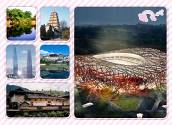| What is the history of Chinese modern architecture? Modern Chinese architecture generally refers to the architecture built since the middle of the 19th century. It was from the end of the first Opium War in 1842, Western architecture appeared in China with the British access to five Chinese ports. At this time, though Chinese architectural styles still dominated traditional building, new types of buildings such as theaters,
| 
|
performance halls, restaurants, hotels, offices, and department stores blended Western and Chinese elements. Then, because of war, the modern architecture developed slowly. After the People’s Republic of China was founded in 1949, the planned economic system accelerated the development of a “modern” architectural style. The most outstanding representative of “New Communist Buildings Period” style is the Big Ten Buildings for National Celebration. The Great Hall of the People, on the western edge of Tiananmen Square in Beijing, built by volunteers in ten months during 1958 and 1959, is used for legislative and ceremonial activities by the People's Republic of China and the Communist Party of China. It has a floor space of more than 170,000 square meters, including 300 meeting halls, lounges and office rooms and a 10,000-seat auditorium for meetings of the National People’s Congress. Since the 1980s, Chinese architectural design has gradually become more open, and exhibits multiple styles. Throughout the twentieth century, Western-trained Chinese architects attempted to incorporate traditional Chinese designs into modern buildings, but only limited success. The pressure of rapid urbanization throughout contemporary China demands for speedier construction of buildings. Therefore, the modern architectures seldom have less than three floors. However, the traditional skills of Chinese architecture, including major carpentry, minor carpentry, masonry, and stone masonry, are still applied to the construction of vernacular architecture in the vast rural area of China. |